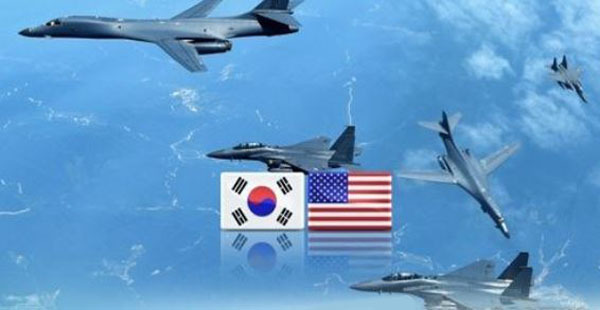Four F-35B stealth jets and two B-1B strategic bombers from the United States trained with South Korea's F-15K fighter jets over the Korean Peninsula on Thursday in response to North Korea's continued ballistic missile launches and nuclear weapons development, the South's Air Force announced.
The unprecedented combined maneuver involved the F-35Bs from Japan and the long-range bombers based in Guam as well as a squadron of four F-15Ks, it said.
They staged air-to-ground precision-strike drills against the North's core facilities over the Pilseung Range in the eastern mountainous province of Gangwon. They used MK-84, MK-82 and GBU-32 bombs.
The Air Force characterized the training as a joint "air interdiction operation," saying it showed the allies' resolve to deal resolutely with the North's provocation that threatens regional and global peace.
 |
(Yonhap) |
Also mobilized was a KC-135 Stratotanker aerial refueling plane, a defense source said.
"Our Air Force has the capability of conducting perfect combined operations," Lt. Gen. Won In-chul, commander of the South Korean Air Force Operations Command. "No matter when, how and where the enemy provokes, we will perfectly retaliate to make it feel an insurmountable sense of fear and deep regret."
The high-profile practice came two days after the North fired an intermediate-range ballistic missile over the northern territory of Japan.
The US warplanes conducted a similar joint training exercise over Japan as well on Thursday in a 10-hour sequenced bilateral mission, which came in direct response to North Korea's latest missile launch, according to the US Pacific Command.
It also represents the "combined ironclad commitment" to the defense of its allies and the US homeland, the Hawaii-based command said in a statement.
The bombers and fighters came just hours after the end of the allies' 11-day Ulchi Freedom Guardian drills.
"North Korea's actions are a threat to our allies, partners and homeland, and their destabilizing actions will be met accordingly," said Gen. Terrence J. O'Shaughnessy, Commander, US Pacific Air Forces.
"This complex mission clearly demonstrates our solidarity with our allies and underscores the broadening cooperation to defend against this common regional threat. Our forward-deployed force will be the first to the fight, ready to deliver a lethal response at a moment's notice if our nation calls," he added.
Gen. Vincent K. Brooks, the commander of US Forces Korea, pointed out the US military opted for the show of force due to the North's disregard for Washington's conciliatory gesture.
"The US did not dispatch bombers during the recently concluded exercise in hopes that the reduced scale would send a positive signal to North Korea and the region," he said in a separate statement. "Instead, North Korea responded to the gesture."
He cited the North's recent rehearsal of special operations raids against South Korea's border islands, three short-range ballistic missile firings and the IRBM launch.
In this year's UFG, largely war games, the US reduced the number of its participating service members to 17,500 from 25,000 in 2016, according to the Pentagon.
Lt. Gen. David H. Berger, commander, US Marine Corps Forces Pacific, underlined the combat readiness of his troops armed with the fifth-generation F-35 fighter jets.
"By forward-basing the F-35, the most advanced aircraft in the world, here in the Pacific, we are enabling the Marine Corps to respond quickly during a crisis in support of Japan, the Republic of Korea, and all our regional partners," he said. (Yonhap)








